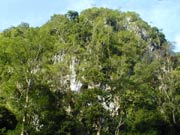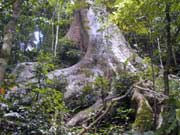 |
|
The Exuberant Rain Forests |
In the 16th and 17th century, the Europeans launched a rush of expeditions. News and fantastic stories about rain forests poured out through the letters and diaries of the explorers and navigators. They saw original rain forests kept out from the sky and giant trees that only many people could
hold their bole hand in hand. The varieties of plants are so abundant that people could not find two trees of the same kind in one place. Within the forest, the vines entangled together and made people difficult to travel in them; many supporting roots dropped down to the ground, as if they came from heaven; some plants did not grow on the grounds, instead, they grew in the forks and branches in different heights, and formed dazzling gardens in the air. They also saw many flowers and fruits grew out on aged roots and stalks. The leaves of some plants are so large that people could find shelters under them during raining, and some leaves could even move when people touched them. Some plants had the shapes of grass but could grow as tall as trees. It was really a fantastic world they saw. Within the rain forest, it was very dark and humid; the explorers was at a loss to the biting of mosquitoes and snakes, and they could even hear thrilling cries uttered when fighting with barbarians from time to time.
 |
|
Rain Forest in Valleys |
These messages are so different with the botanical knowledge of the Europeans at that time; thus, the rain forests were covered with an ancient, a mysterious and fascinating veil.
Until the 19th century, a German botanist collected and summarized many scientific discoveries and various materials in tropical areas; and he called the evergreen arbor forests in the humid tropical areas as rain forest and he also gave a more scientific description of the rain forest in his point of view.
 |
|
Rain Forest in Valleys |
The rain forest has unique appearance and structural features and it has clear distinctions with other forest types of the world. Rain forests mainly grow in humid low places in tropical areas, where the annual average temperatures are over 24oC and the monthly average temperature of the coldest month is above 18oC. There are rain forests in all the three tropical districts of the world. The largest rain forest is in America, and it has an area of 40000 square kilometers; it accounts for 50% of the world rain forests and about one 6th of the broad leave forests in the world. The second largest rain forest is in the tropical Asia, it has an area of 20000 square kilometers; and the third largest rain forest is in Africa, and it has an area of 18000 square kilometers.
Though the three pieces of rain forest separately situate in America, Asia and Africa, they have quite similar outer appearances and structural features. Since their growing environments have high temperatures and are quite humid, the rain forests grow very tall and quite densely, with a general height of over 30 meters; from the top of the trees to underneath the forest, there are many layers of tress overlap on one another. In the rain forest, the highest trees could grow to as tall as 80 meters, such as the
Koompassia excelta of Malaysia; and the Shorea chinensis of Xishuangbanna also has a height of 70 meters. The plant varieties in the rain forest are quite varied, in spite that the rain forests only take up about 7% of the total land area of the world, the plant varieties they cover claim for more than half of the world. There are also many phenomena that could not be found in other forests of the world. For example, big trees have board-like
roots; plants abloom and fructify on aged stalks; many small plants are
adnascent to the trunks and branches of other plants; some plants grow up through entangling other plants; some plants hang many pillar-like roots in the air, and they could become one-tree forest at last. The leaves of plants beneath the forest generally have tipped leaves for dropping of water, and some other plants have very big leaves; within the forest, large vines are many, some could grow as long as hundreds of meters, they penetrate the forest and hang in-between trees,
making it very difficult to travel in the forest.
 |
 |
|
|
Buttressus Root |
As more and more scientists began to study and to investigate into the secrets of the rain forests, more and more biological phenomena are discovered and explained. But more and more discoveries also disclose that there is still a huge amount of biological and natural laws of the rain forests are not
been recognized sufficiently. In particular, they found that many phenomena could not be explained by the Evolutionism of Charles Darwin. All the species outside the rain forest at most take up half of all species and their plant living types are only part of the plants. So to speak, the forests in the temperate zone not only lack in varieties, they also have an inanimate living style; and their ecological relations and manifestations are relatively simple and direct. The biological rules and concepts we have drawn from studies beyond rain forests are far from complete and perfect; if we use them to interpret the phenomena in rain forests, many natural phenomena are enigmatical. Therefore, the scientists predict that, through deep studies on rain forest, the mankind may change its original biological concepts. However, what is regretful is that, human beings may have destroyed all the rain forests completely before we solve all our puzzles for the rain forests.
 
|

